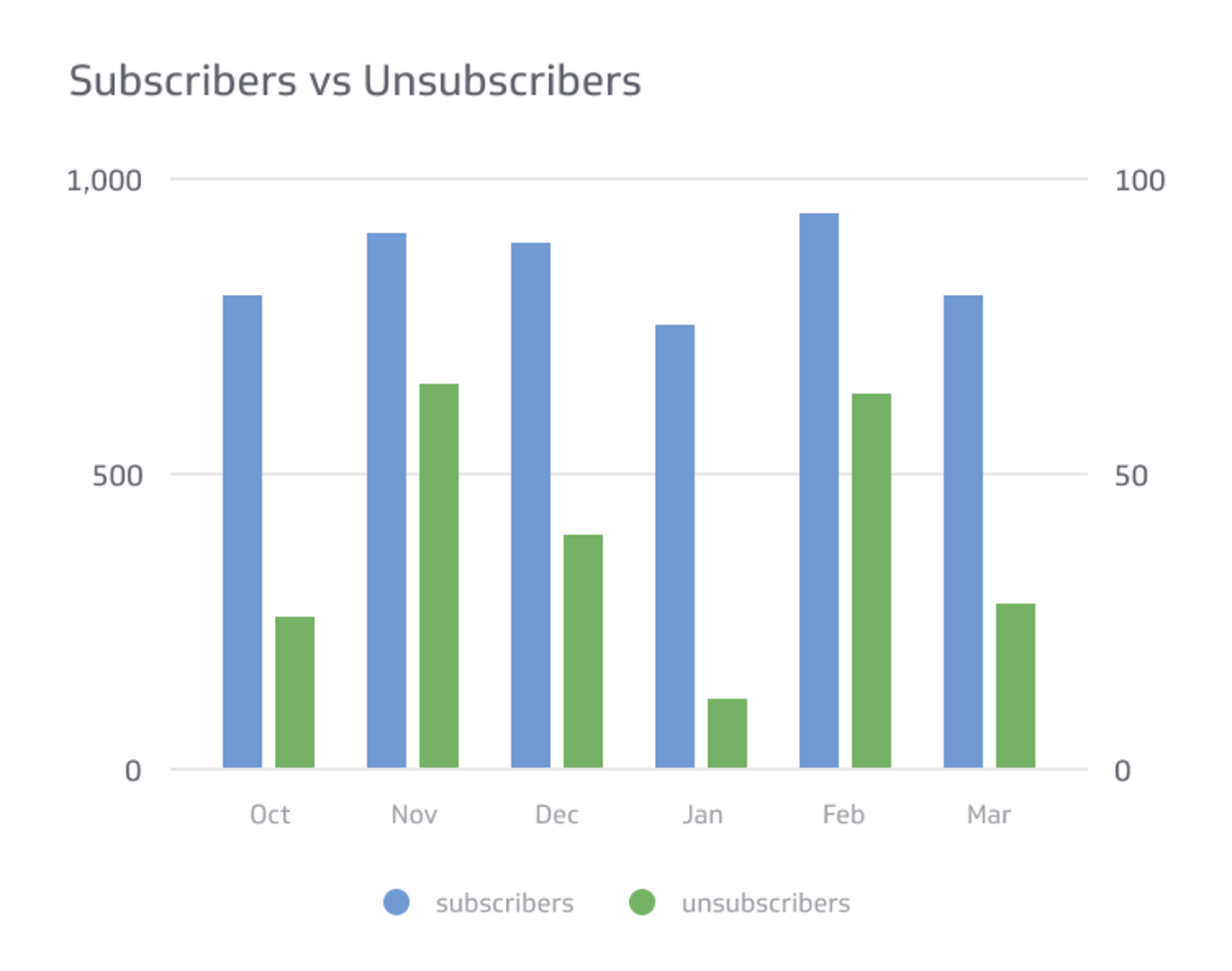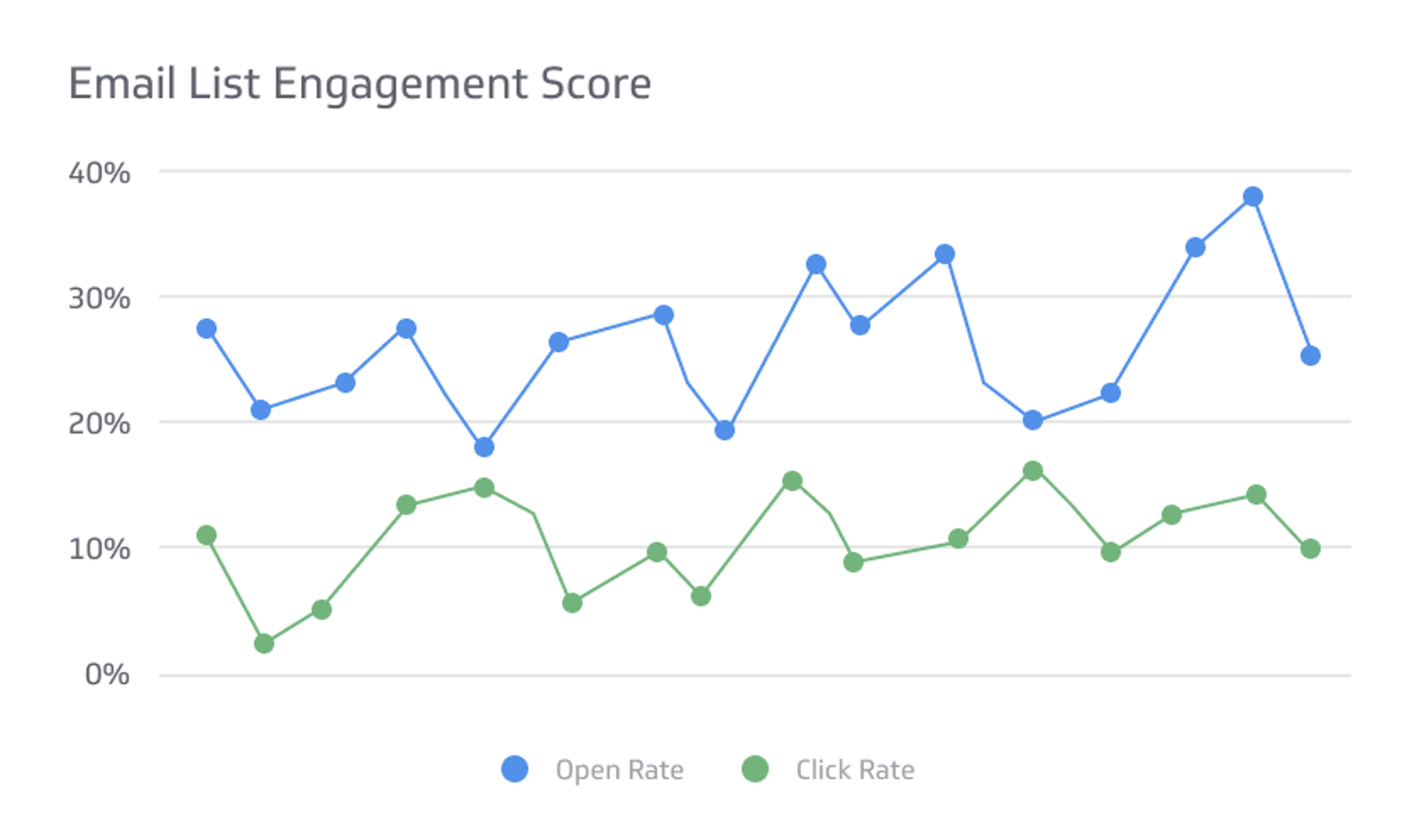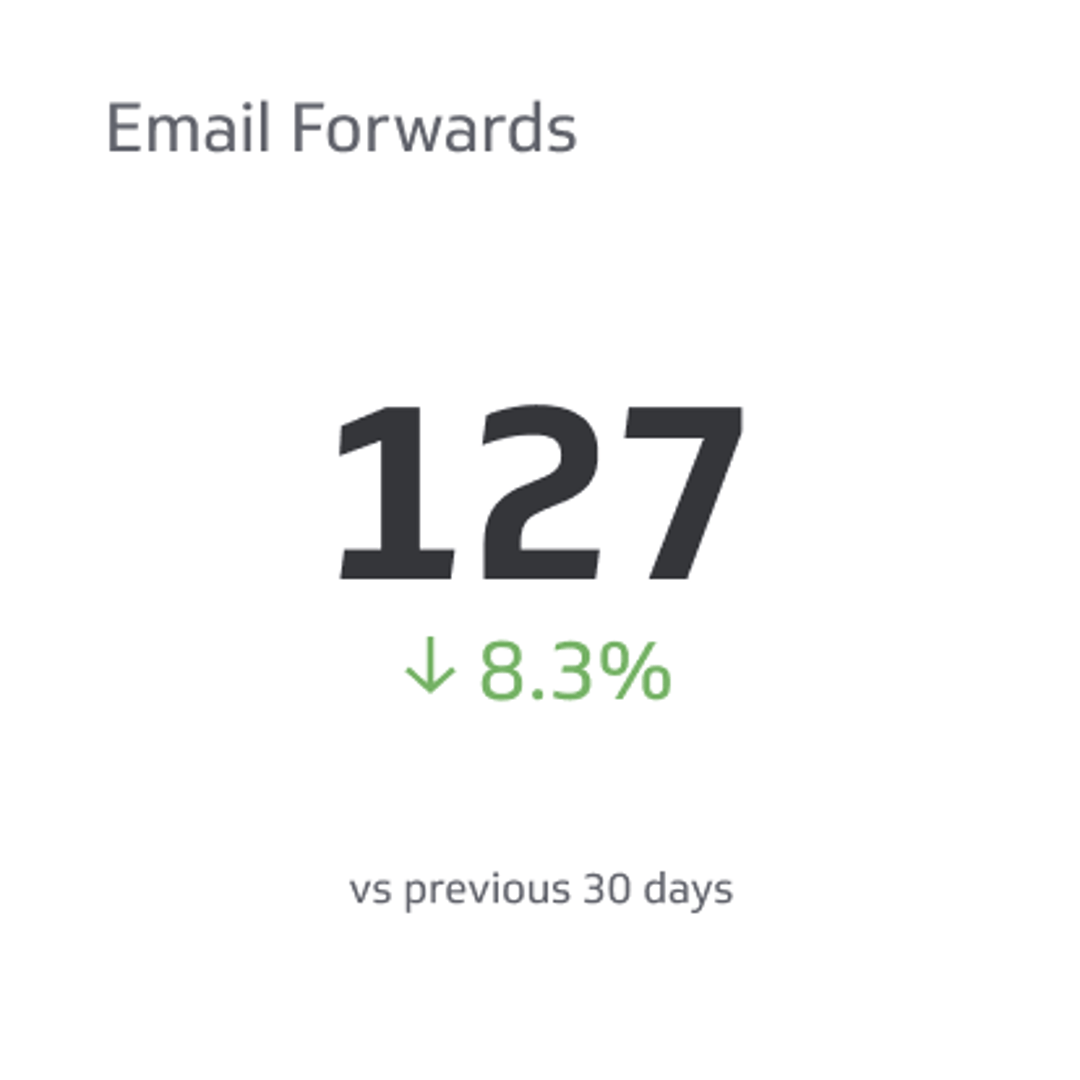Email Click Through Rate (CTR)
Your click-through rate speaks to how many recipients of your email clicked on the link embedded in your email, in other words, how many people engaged with your content.
Track all your Email Marketing KPIs in one place
Sign up for free and start making decisions for your business with confidence.

Creating and launching an email marketing campaign takes a lot of work. The many factors associated with email marketing are often complex, from design to content. When you have launched your email campaign, it can feel like you have reached the end of all that work!
However, marketing campaigns are just a shot in the dark unless you capitalize on available metrics to create data-driven campaigns. Marketers and business owners have a wealth of metrics to leverage to improve their promotional campaigns, including conversion, bounce, and list growth rates.
Your email click-through rate is a crucial indicator of audience engagement—and without attention, your campaigns are virtually helpful. To that end, email click-through rate is the cornerstone of email marketing, and it’s the most important KPI you need to understand to create more impactful and lucrative campaigns.
Use this guide to learn everything you need about email click-through rates, including how to calculate and improve it.
What is Email Click Through Rate?
When you launch an email marketing campaign, you expect your audience to react to your content somehow.
You might want them to click on your product, sign up for a newsletter, or donate to a campaign or cause.
Every email that you send to your prospective clients ultimately has a purpose, and it’s here that the click-through rate becomes an important metric to keep front of mind.
Your click-through rate speaks to how many recipients of your email clicked on the link embedded in your email, in other words, how many people engaged with your content.
The click-through rate is distinct from the open email rate. Your email availability rate is essential, as it lets you know how many people opened it. This is an essential first step since 80% of emails are left unopened daily.
However, an open rate tells you little about whether or not clients are engaging with your advertisements, and taking action is what matters.
For this reason, email click-through rate is the most critical metric in email marketing.
Why is CTR Important?
Nowadays, it seems like everyone’s inbox is flooded with marketing emails.
You might wonder why so many marketing teams focus on email marketing.
Research suggests that email marketing is among the most potent forms of marketing, generating 42 dollars back for every dollar you spend.
Despite the many unopened emails, email marketing continues to boast the highest return on investment out of any marketing strategy.
However, emails are virtually useless if they aren’t acted upon. For your email marketing campaign to generate ROI, it has to incite some action on the part of the consumer.
Your click-through rate lets you know how many of your viewers took the action you wanted them to take.
When considering CTR, consider what you want to accomplish with your email marketing campaign. CTR becomes a way to measure the efficacy of that objective, like how many clients responded precisely the way you wanted them to.
For this reason, the email click-through rate is crucial to the smooth functioning of any data-driven campaign.
How to Calculate Email Click-Through Rate
Calculating email click-through rates is relatively simple.
You’ll divide the number of people who clicked on a given link in your email by the total number of recipients for that email. Then, you can divide that number by 100 to generate a percentage of persons who clicked through your email.
For example, if you send an email to 10,000 people, and 850 people open your email, your click-through rate is 8.5%.
The equation for the click-through rate is:
Number of people who clicked your link / Total number of recipients / 100
Indicators of a Strong CTR
Many factors can affect your email click-through rate.
Like many other metrics, the click-through rate should not be evaluated independently. You’ll need to, for example, determine how much you spent on the campaign and assess that against ROI.
Additionally, CTR can change depending on which device customers are using and what time of day you sent the email.
For this reason, the email click-through rate on its own may be insufficient in determining your campaign’s success.
However, an optimal click-through rate is upwards of 6%. The average email CTR is between 1.9% and 2.6%, so anything above that number counts as above average.
Factors Affecting Email Click-Through Rate
There are many factors at play in determining your email click-through rate.
It’s essential to consider each one and assess how they might impact the overall success of your campaign.
Consider the following factors affecting CTR.
Call-to-Action
Your call to action is the button that directs your audience to a given link.
If your CTR is deeply embedded in your content or hard to access from a mobile device, your audience is less likely to click through.
You can adjust for this by featuring the CTA button in a prominent location, preferably towards the beginning, in the banner, or towards the end of the email copy.
Device Used
Email click-through rates can vary depending on how your audience accesses the email.
For example, clients accessing your email campaign through a desktop are 7% more likely to click through your content.
People are more likely to scan through and close their emails on mobile devices before clicking around since it requires more investment.
However, you can accommodate these differences by designing email campaigns adapted to mobile users' needs. These campaigns are more likely o generate a higher click-through rate when accessed from a mobile device.
Subject Line & Keywords
Most email service providers (ESPs) use scanners to determine if an email is spam.
If you aren’t careful, you might use specific keywords that will get your email flagged for spam, causing the client to miss the email.
The following factors can affect your email click-through rate:
- Using strong language (“amazing.” “incredible,” etc.)
- Using capital letters, block letters, or emojis in the subject line
- Mentioning prices or discounts
- Using sales language
Bounce Rate
Bounce rate refers to a phenomenon whereby audience members click on a link or page but leave the page before taking action.
In email marketing, bounce rate refers to the rate at which clients opened the email but did not click on the CTA. You can calculate the bounce rate by dividing the number of clients who took no action by the total number of people who opened the email (the open rate).
If you send an email to an invalid email address, or your design needs to be optimized for the device your clients are using, you might experience a high bounce rate, causing a dent in your overall click-through rate.
Top 7 Industry-Leading Tips To Improve Your CTR
Email click-through rate is a wildly popular metric. For this reason, there are many industry-lading tips and best practices that you can capitalize on to improve your overall CTR. You can avoid spending time and money on experimentation by leveraging these strategies.
Consider the following strategies before designing your next campaign.
Generate Relevant Content and Subject Lines
Creating compelling and relevant content is the first step to increasing your click-through rate. If your email doesn’t appear relevant to your recipients, they will likely ignore or delete it since most people check their emails when busy at work.
You can improve your click-through rate by ensuring your content is relevant to your audience and using solid subject lines.
Your subject line should make the reader want to open the email and learn more about your product or service. You can improve your subject lines by using A/B testing to determine which lead-ins work best.
Give Permission to Share
When you launch an email marketing campaign, you likely want it to be as effective as possible.
To accomplish that goal, you should make your emails shareable. Adding a share button can prompt readers to share your email with others who might be interested, increasing your overall reach.
Use branded buttons to make it easy to share your emails to social media networks, too, as this can dramatically heighten your click-through rate.
Personalize Your Emails
Research suggests that recipients are 26% more likely to open an email if they see their name in the subject line.
To that end, personalizing your emails can be a great way to ensure your customers open and click through your content.
Remember to use this strategy sparingly, as too much personalization can be a turn-off for your audience and have the opposite effect.
Leverage Enticing Headers and Images
Once you have enticed your recipient to open your email, the next crucial step is to captivate and retain their interest throughout its contents.
To achieve this, it's essential to ensure that your email content remains relevant, engaging, and visually appealing. One powerful strategy is to incorporate captivating headlines that instantly grab attention and pique curiosity. Additionally, complementing your well-crafted copy with stunning visuals can further enhance the overall impact of your message.
By leveraging the combination of compelling headlines and visually appealing images, you create a captivating experience that entices your recipients to keep reading and actively engage with your email campaign.
Keep Your Copy Focused
When it comes to marketing copy, less is more. Ensure that you’ve optimized your text, keeping it slim and concise.
Additionally, the action you want your customer to take should be explicit. Resist the urge to add multiple links or CTAs to direct your viewer to your website or additional pages. Keep distracting text and images at a minimum and focus on accomplishing just one purpose.
Test and Adjust Your Campaigns
Testing is not just a valuable asset but the lifeblood of the marketing industry. It is imperative to thoroughly assess important metrics for each email you send, such as click-through rates (CTR).
In addition, leveraging the power of A/B testing enables you to meticulously analyze and compare different strategies to determine the most effective approach and optimal timing.
However, going beyond a surface-level examination of your data is essential. Dive deeper into the insights gained, and use them to curate your next campaign, ensuring it adapts and evolves based on the lessons learned.
By constantly refining your marketing efforts, you pave the way for enhanced results and improved customer engagement.
Use Buttons
Many marketers embed their links in the email copy. However, this strategy is a surefire way to ensure your audience will miss your call to action, lowering your click-through rate.
To that end, you’ll want to use buttons instead of embedded links. Controls are more visible and keep the purpose of your email front and center.
Keep your text brief and actionable, include a CTA in your banner (or above the fold), and add a secondary CTA at the end if you wish for added effect.
Frequently Asked Questions
Consider the following answers to the most frequently asked click-through rate questions.
What is the Difference Between Email Open Rate and Click Through Rate?
Your email open rate refers to the rate at which your audience opens the email.
The click-through rate refers to the percentage of viewers who not only opened the email but also took a given action within that email.
What is a Good Email CTR?
CTR differs depending on the type of campaign, and it is subject to different factors.
However, the average click-through rate is around 2%, so anything above that counts as above average. A strong click-through rate is upwards of 6%.
Wrapping Up: Leveraging Email Click-Through Rate
Email click-through rate is one of the most critical metrics for marketing teams and business owners to consider. Remember to acknowledge and use your data to derive more data-driven campaigns if you plan to leverage email marketing.
Remember that the click-through rate takes time to improve, and you might need to experiment with different strategies. Once you get it down, you’ll reap the many benefits of using click-through rate as a marketing metric.
Related Metrics & KPIs



